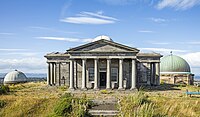City Observatory, Edinburgh

Front of the Playfair Building
|
|||||
| Code | 961 | ||||
|---|---|---|---|---|---|
| Location | Calton Hill, Edinburgh, Scotland | ||||
| Coordinates | 55°57′17″N 3°11′0″W / 55.95472°N 3.18333°WCoordinates: 55°57′17″N 3°11′0″W / 55.95472°N 3.18333°W | ||||
| Altitude | 107 m | ||||
| Established | 1776 | ||||
| Closed | 2009 | ||||
| Telescopes | |||||
|
|||||
|
[]
|
|||||
| Cooke / McEwan | refractor, 15 cm aperture |
|---|---|
| Fraunhofer / Repsold | transit telescope, 16 cm aperture |
The City Observatory is an astronomical observatory on Calton Hill in Edinburgh, Scotland. It is also known as the Calton Hill Observatory.
The site is enclosed by a boundary wall with a monument to John Playfair, president of the Edinburgh Astronomical Institution, in the southeast corner. The oldest part is the Gothic Tower in the southwest corner, facing Princes Street and Edinburgh Castle. It is also known as Observatory House, the Old Observatory, or after its designer James Craig House. The central building with the appearance of a Greek temple is the Playfair Building, named after the building's designer William Henry Playfair. This houses the 6-inch (15 cm) refractor in its dome and the 6.4-inch (16 cm) transit telescope in its eastern wing. The largest dome of the site is the City Dome in the northeast corner. During the early 20th century this contained a 22-inch (56 cm) refractor.
In 1776 Thomas Short returned to Edinburgh, bringing with him a 12-foot (3.7 m, focal length) reflecting telescope made by his late brother James Short. He intended to open a public observatory on Calton Hill as a commercial enterprise. However, in 1736 Colin Maclaurin, professor of mathematics at the University of Edinburgh, had collected funds for a university observatory. Due to the Porteous Riots and the Jacobite Rebellion of 1745 the funds were left unused. These were made available to build Short's observatory; and the City of Edinburgh provided a plot of land on Calton Hill. The observatory was to be open to university students.
...
Wikipedia
